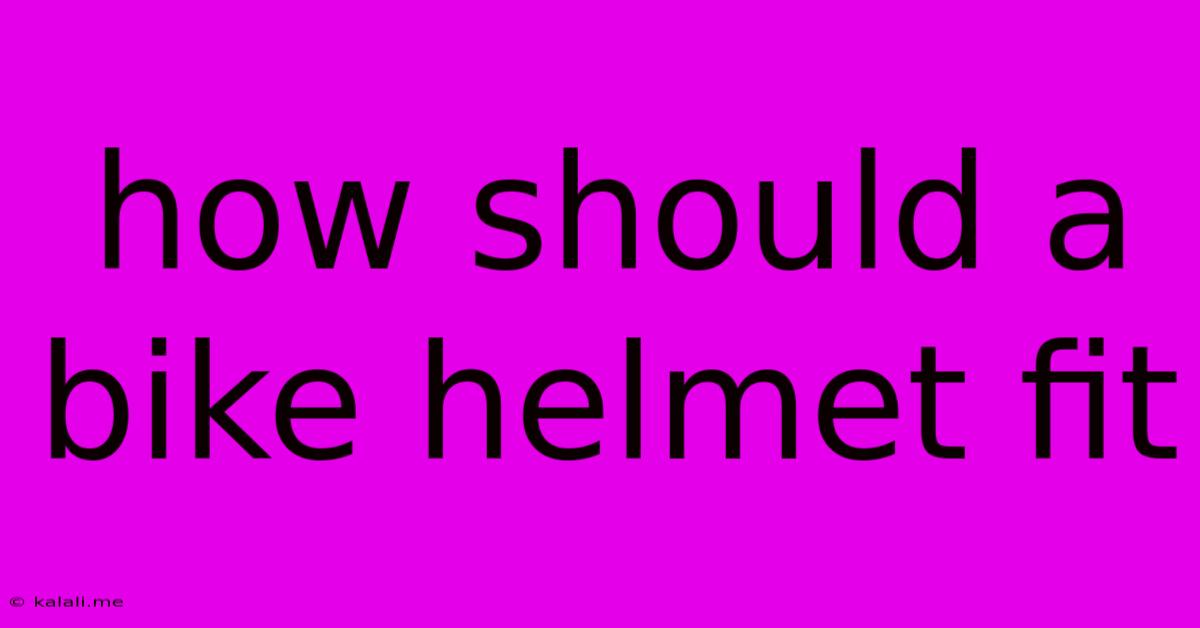How Should A Bike Helmet Fit
Kalali
May 31, 2025 · 3 min read

Table of Contents
How Should a Bike Helmet Fit? A Comprehensive Guide to Safety and Comfort
Finding the right bike helmet is crucial for your safety. A poorly fitting helmet, no matter how expensive, offers significantly reduced protection in a crash. This guide will walk you through how to ensure your helmet provides optimal safety and comfort. Understanding proper fit is the first step towards confident and safe cycling.
The Importance of a Properly Fitting Helmet
A helmet's primary function is to protect your head from impacts during a fall. An ill-fitting helmet can shift during a collision, leaving vulnerable areas exposed. This significantly diminishes its protective capabilities. Furthermore, a helmet that's too loose or too tight can be uncomfortable, leading to rider distraction and potentially causing you to take it off, leaving your head unprotected. Investing time in finding the perfect fit is an investment in your safety.
Key Factors for a Proper Fit:
Several key factors determine whether your helmet fits correctly. Let's explore each one in detail:
-
Level Position: The helmet should sit level on your head, not tilted forward or backward. The front edge should be roughly one to two finger-widths above your eyebrows.
-
Snugness: The helmet should feel snug but not tight. You should be able to comfortably fit two fingers between your eyebrows and the helmet's front edge. This ensures the helmet stays in place during movement, but avoids uncomfortable pressure.
-
Straps: The straps should form a "V" shape under your ears. They shouldn't be too tight or too loose. When properly adjusted, you should be able to open your mouth comfortably without the helmet shifting.
-
Buckle: The buckle should be easy to fasten and unfasten, and it should sit comfortably against your chin without pinching. It's crucial the buckle doesn't interfere with your neck's movement.
-
Helmet Size and Shape: Helmets come in various sizes and shapes to accommodate different head sizes and shapes. Measure your head circumference to find the appropriate size. Consider the helmet's shape as well; some designs better suit oval-shaped heads, while others are suited for rounder heads.
How to Properly Adjust Your Helmet:
-
Adjust the Fit Dial: Most helmets have an adjustment dial at the back. Use this to tighten or loosen the helmet until you achieve a secure and comfortable fit.
-
Position the Straps: Ensure the straps form a "V" shape under your ears, and adjust them until they are snug but not too tight.
-
Fasten the Buckle: Secure the buckle comfortably under your chin. It should be easy to fasten and unfasten but remain secure during riding.
-
Test the Fit: Before heading out for a ride, move your head from side to side and up and down. The helmet should remain securely in place, without any shifting or pressure points.
Choosing the Right Helmet Type:
While the fit principles remain consistent, different cycling disciplines might require helmets with specific features. Road cycling helmets are typically lighter and more aerodynamic, while mountain bike helmets often have more comprehensive protection and visors. Always choose a helmet designed for your intended activity.
When to Replace Your Helmet:
Even a properly fitting helmet needs replacing eventually. Replace your helmet after any significant impact, no matter how minor it might seem. The internal structure might be compromised, even if the exterior appears undamaged. Also, consider replacing your helmet every 3-5 years due to the degradation of materials over time.
Following these guidelines will significantly increase your chances of selecting a helmet that offers optimal safety and comfort. Remember, a properly fitting helmet is your best defense against head injuries while cycling. Always prioritize safety and invest in a helmet that fits correctly and suits your cycling needs.
Latest Posts
Latest Posts
-
Use In Contrast In A Sentence
Jun 02, 2025
-
What To Put Under Above Ground Pool
Jun 02, 2025
-
After Cutting Into Floor Joist Where To Locate Mending Plate
Jun 02, 2025
-
What Did It Take To Break Through Full Plate Armor
Jun 02, 2025
-
Can You Wash Your Car On Townhouse Driveway
Jun 02, 2025
Related Post
Thank you for visiting our website which covers about How Should A Bike Helmet Fit . We hope the information provided has been useful to you. Feel free to contact us if you have any questions or need further assistance. See you next time and don't miss to bookmark.